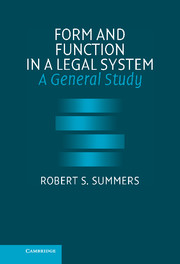Book contents
- Frontmatter
- Contents
- Preface
- Acknowledgments
- PART ONE INTRODUCTION, BASIC CONCEPTS AND DEFINITIONS, AND A GENERAL APPROACH
- PART TWO THE FORMS OF FUNCTIONAL LEGAL UNITS
- PART THREE THE OVERALL FORM OF A LEGAL SYSTEM AND ITS OPERATION
- 10 The Overall Form of a Legal System as a Whole
- 11 Cumulative and Synergistic Effects of Legal Forms – A Schematic Practical Application
- Name Index
- Subject Index
11 - Cumulative and Synergistic Effects of Legal Forms – A Schematic Practical Application
Published online by Cambridge University Press: 29 July 2009
- Frontmatter
- Contents
- Preface
- Acknowledgments
- PART ONE INTRODUCTION, BASIC CONCEPTS AND DEFINITIONS, AND A GENERAL APPROACH
- PART TWO THE FORMS OF FUNCTIONAL LEGAL UNITS
- PART THREE THE OVERALL FORM OF A LEGAL SYSTEM AND ITS OPERATION
- 10 The Overall Form of a Legal System as a Whole
- 11 Cumulative and Synergistic Effects of Legal Forms – A Schematic Practical Application
- Name Index
- Subject Index
Summary
“Laws, like houses, lean on one another… .”
– E. Burke“With the right combinations, one and one can make three.”
– S. KimbleINTRODUCTION
A highly concrete, felicitous, and revealing way to draw together, summarize, and highlight major contributions of duly designed form in a standard modern use of law that has itself been highly successful, is: (1) to present a synoptic overview of the main stages in an illustrative linear progression in which functional legal units are deployed concurrently or in sequence to create and to implement law to serve a standard legal policy, (2) to identify how systematizing devices, and resultant formal features of the legal system as a whole, contribute in this overall process, focusing especially on how various legal units are, at these main stages, combined, integrated, and coordinated within one or more of the law's five basic operational techniques for the creation and implementation of law, all in accord with principles of the rule of law, (3) to identify and review how major choices of form and of complementary material or other components in discrete legal units, and how major choices of form in the formation of the system as a whole, contribute by way of imprints and other effects to the operation of this progression at each stage, and (4) to consider the cumulative and synergistic effects of such choices of form and complementary material and other components, at each stage and at subsequent stages of the progression, as these imprints and other effects converge and add up in the processes and outcomes involved, and thus ultimately contribute to the realization of purposes.
- Type
- Chapter
- Information
- Form and Function in a Legal SystemA General Study, pp. 351 - 392Publisher: Cambridge University PressPrint publication year: 2005



